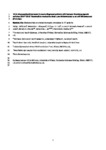Glucocorticoid treatment in patients with newly diagnosed immune thrombocytopenia switches CD14 ++ CD16 + intermediate monocytes from a pro‐inflammatory to an anti‐inflammatory phenotype
| dc.contributor.author | Williams, EL | |
| dc.contributor.author | Stimpson, ML | |
| dc.contributor.author | Lait, PJP | |
| dc.contributor.author | Schewitz‐Bowers, LP | |
| dc.contributor.author | Jones, LV | |
| dc.contributor.author | Dhanda, Ashwin | |
| dc.contributor.author | Lee, RWJ | |
| dc.contributor.author | Bradbury, CA | |
| dc.date.accessioned | 2021-08-12T13:26:45Z | |
| dc.date.issued | 2021-01-18 | |
| dc.identifier.issn | 0007-1048 | |
| dc.identifier.issn | 1365-2141 | |
| dc.identifier.uri | http://hdl.handle.net/10026.1/17568 | |
| dc.description.abstract |
<jats:title>Summary</jats:title><jats:p>Immune thrombocytopenia (ITP) is thought to result from an aberrant adaptive autoimmune response, involving autoantibodies, B and T lymphocytes, directed at platelets and megakaryocytes. Previous reports have demonstrated skewed CD4<jats:sup>+</jats:sup> T‐helper subset distribution and enhanced production of pro‐inflammatory cytokines such as interleukin 17A and interferon gamma. The role of monocytes (MCs) in ITP is less widely described, but innate immune cells have a role in shaping CD4<jats:sup>+</jats:sup> T‐cell phenotypes. Glucocorticoids (GCs) are commonly used for first‐line ITP treatment and modulate a broad range of immune cells including T cells and MCs. Using multiparameter flow cytometry analysis, we demonstrate the expansion of intermediate MCs (CD14<jats:sup>++</jats:sup>CD16<jats:sup>+</jats:sup>) in untreated patients with newly diagnosed ITP, with these cells displaying a pro‐inflammatory phenotype, characterised by enhanced expression of CD64 and CD80. After 2 weeks of prednisolone treatment (1 mg/kg daily), the proportion of intermediate MCs reduced, with enhanced expression of the anti‐inflammatory markers CD206 and CD163. Healthy control MCs were distinctly different than MCs from patients with ITP before and after GC treatment. Furthermore, the GC‐induced phenotype was not observed in patients with chronic ITP receiving thrombopoietin receptor agonists. These data suggest a role of MCs in ITP pathogenesis and clinical response to GC therapy.</jats:p> | |
| dc.format.extent | 375-384 | |
| dc.format.medium | Print-Electronic | |
| dc.language | en | |
| dc.language.iso | en | |
| dc.publisher | Wiley | |
| dc.rights | Attribution-ShareAlike 4.0 International | |
| dc.rights | Attribution-ShareAlike 4.0 International | |
| dc.rights | Attribution-ShareAlike 4.0 International | |
| dc.rights | Attribution-ShareAlike 4.0 International | |
| dc.rights | Attribution-ShareAlike 4.0 International | |
| dc.rights | Attribution-ShareAlike 4.0 International | |
| dc.rights.uri | http://creativecommons.org/licenses/by-sa/4.0/ | |
| dc.rights.uri | http://creativecommons.org/licenses/by-sa/4.0/ | |
| dc.rights.uri | http://creativecommons.org/licenses/by-sa/4.0/ | |
| dc.rights.uri | http://creativecommons.org/licenses/by-sa/4.0/ | |
| dc.rights.uri | http://creativecommons.org/licenses/by-sa/4.0/ | |
| dc.rights.uri | http://creativecommons.org/licenses/by-sa/4.0/ | |
| dc.subject | autoimmunity | |
| dc.subject | glucocorticoids | |
| dc.subject | steroids | |
| dc.subject | immune thrombocytopenia | |
| dc.subject | monocyte subsets | |
| dc.title | Glucocorticoid treatment in patients with newly diagnosed immune thrombocytopenia switches CD14 ++ CD16 + intermediate monocytes from a pro‐inflammatory to an anti‐inflammatory phenotype | |
| dc.type | journal-article | |
| dc.type | Journal Article | |
| dc.type | Research Support, Non-U.S. Gov't | |
| plymouth.author-url | https://www.webofscience.com/api/gateway?GWVersion=2&SrcApp=PARTNER_APP&SrcAuth=LinksAMR&KeyUT=WOS:000599752000001&DestLinkType=FullRecord&DestApp=ALL_WOS&UsrCustomerID=11bb513d99f797142bcfeffcc58ea008 | |
| plymouth.issue | 2 | |
| plymouth.volume | 192 | |
| plymouth.publication-status | Published | |
| plymouth.journal | British Journal of Haematology | |
| dc.identifier.doi | 10.1111/bjh.17205 | |
| plymouth.organisational-group | /Plymouth | |
| plymouth.organisational-group | /Plymouth/Faculty of Health | |
| plymouth.organisational-group | /Plymouth/Faculty of Health/Peninsula Medical School | |
| plymouth.organisational-group | /Plymouth/REF 2021 Researchers by UoA | |
| plymouth.organisational-group | /Plymouth/REF 2021 Researchers by UoA/UoA01 Clinical Medicine | |
| plymouth.organisational-group | /Plymouth/REF 2021 Researchers by UoA/UoA01 Clinical Medicine/UoA01 Clinical Medicine | |
| plymouth.organisational-group | /Plymouth/Research Groups | |
| plymouth.organisational-group | /Plymouth/Research Groups/Plymouth Institute of Health and Care Research (PIHR) | |
| plymouth.organisational-group | /Plymouth/Users by role | |
| plymouth.organisational-group | /Plymouth/Users by role/Academics | |
| dc.publisher.place | England | |
| dcterms.dateAccepted | 2020-09-17 | |
| dc.rights.embargodate | 2021-8-14 | |
| dc.identifier.eissn | 1365-2141 | |
| dc.rights.embargoperiod | Not known | |
| rioxxterms.versionofrecord | 10.1111/bjh.17205 | |
| rioxxterms.licenseref.uri | http://creativecommons.org/licenses/by-sa/4.0/ | |
| rioxxterms.licenseref.startdate | 2021-01-18 | |
| rioxxterms.type | Journal Article/Review |



